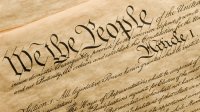Using Webb’s Depth of Knowledge to Teach the U.S. Constitution
Norman Webb’s framework is an invaluable scaffold in guiding high school students to understand this founding document more deeply.
Your content has been saved!
Go to My Saved Content.Surveys indicate that many Americans know little about the U.S. Constitution, so how can teachers help students better understand the structure and principles of this founding document? Using Norman Webb’s Depth of Knowledge Levels, a teaching and learning strategy, can help.
Webb’s Depth of Knowledge (DoK) provides an effective framework for teaching the Constitution and allows teachers to scaffold the lessons, assess student learning, provide feedback, and employ interventions in a targeted and incremental manner. Webb’s DoK also enables opportunities for differentiation and gives educators the freedom to tailor lessons to the needs and skill sets of different classrooms.
The DoK “categorizes tasks according to the complexity of thinking required to successfully complete them.” The model has four levels: Recall and Reproduction, Skills and Concepts, Strategic Thinking, and Extended Thinking. Each level requires students to think in more conceptual ways.
Level 1: Recall and Reproduction
Webb’s first level entails learning important foundational knowledge from which students will draw in the higher levels. This level focuses on the journalistic who, what, when, where, why, and how questions.
In this section, students learn the basics of the Constitution: definitions of “article” and “amendment,” the number and purposes of each, and the structure of the document (e.g., preamble).
Teachers can assess this section with multiple-choice, fill-in-the-blank, and matching questions. Consider chunking or scaffolding this section (e.g., articles, Bill of Rights, Civil War amendments, 20th-century amendments).
This section lends itself to differentiation. If students have difficulty memorizing material, have them familiarize themselves with finding relevant information in the Constitution. Ask basic questions, and allow students access to the document when they answer.
Level 2: Basic Application of Skills and Concepts
This is where I tie U.S. history to the creation of the Constitution. Two of the questions I ask: Why did the framers write this amendment or article? What historical events informed 19th- or 20th-century political leaders’ decision to draft and ratify this amendment?
DoK Level 2 activities include the following:
- Cause/effect graphic organizer: Write down the historical event that precipitated the passage of the amendment (e.g., Vietnam War and 26th Amendment).
- Categorize the amendments (e.g., amendments that deal with voting or civil rights). This aids in identifying patterns.
- Ask students to trace the history of an amendment by creating a list, comic strip, or series of images.
Level 3: Strategic Thinking
The penultimate level encourages students to make real-world connections with the material they’ve learned. Link the Constitution to students’ lives or to events occurring in the world.
Keep in mind, it’s important that students cite textual evidence to support their conclusions. I don’t require them to write lengthy responses. I ask them, rather, to produce concise answers based on an advanced understanding of the concepts and text. This can be a verbal response or a short piece of writing.
Help them identify constitutional principles in current events. For example, a news piece exploring modern issues regarding surveillance and privacy might parallel the Fourth Amendment concerns of the framers. A story about the lack of press freedom in an authoritarian country offers an entry point to discuss the First Amendment.
Current and past Supreme Court cases are always an enriching way to think strategically about the U.S. Constitution:
- Investigate or critique a Supreme Court case that helped define and interpret the Constitution.
- Compare two Supreme Court justices’ interpretations of the Constitution using excerpts of the written opinions.
Level 4: Extended Thinking
In this last level, students should conduct a much more sophisticated analysis and interpretation of the Constitution. Ideally, they’d also create something new based on their deep reading of the document and examination of any supplemental material. Students can produce a video, speech, paper, or project.
One option is to have students build upon existing work they did in the previous DoK level. If a student read a piece about the presidential election and connected it to the provisions set forth in Article II, urge them to go a little bit deeper by drawing on other resources. They might want to consult the Federalist Papers or delve into the debate surrounding the Electoral College.
Another fun project is to have students design their own amendment. For background, read the “We the People” series in The New York Times. In it, prominent thinkers argue for their own new amendment to the Constitution. Students can model their amendment off the ones they read there. Or, students can identify a national problem and craft an amendment as a remedy.
The DoK model allows for a great deal of flexibility for educators teaching the Constitution, as teachers can pace the lessons according to the needs of the class. The four levels also provide clear points at which teachers can administer tests. Most important, the model is by nature a scaffolded approach to teaching and learning.
